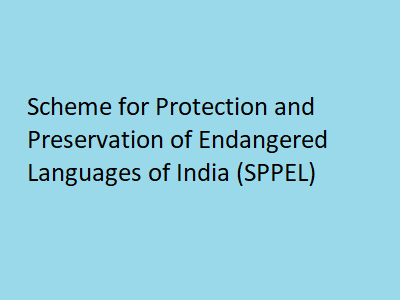Scheme for Protection and Preservation of Endangered Languages of India (SPPEL)
Context:
Under this Scheme, the Central Institute of Indian Languages (CIIL), Mysore works on protection, preservation and documentation of all the mother tongues/languages of India spoken by less than 10,000 people which are called endangered languages.
Contents
ABOUT SPPEL
Galvanized by the grim situation of lesser known languages in the country, the Scheme for Protection and Preservation of Endangered Languages (SPPEL) was instituted by Ministry of Education (Government of India) in 2013. The sole objective of the Scheme is to document and archive the country’s languages that have become endangered or likely to be endangered in the near future. The scheme is monitored by Central Institute of Indian Languages (CIIL) located in Mysuru, Karnataka. The CIIL has collaborated with various universities and institutes across India for this mission.
At the moment, the languages which are spoken by less than 10,000 speakers or languages which are not linguistically studied earlier are chiefly considered to be documented in this Government of India scheme. Presently, 117 languages have been listed for the documentation. Documentation in the form of grammar, dictionary and ethno-linguistic profiles of about 500 lesser known languages are estimated to be accomplished in the coming years
Central Institute of Indian Languages (CIIL)
- Central Institute of Indian Languages (CIIL) was established in 1969.
- It is under the administrative control of Ministry of Human Resource Development.
Causes For Decline
- GOI does not recognize languages with less than 10,000 speakers
- In and out migration of communities which leads to dispersal of traditional settlement.
- Changing employment pattern which favours majority language.
- Changes in social and cultural values.
- Growth of “individualism”, which puts self interest over that of community.
- Encroachment of materialism in traditional communities allowing spiritual, moral and ethical values being overshadowed by consumerism.
ENDANGERED LANGUAGES IN ZONEWISE
NORTHERN ZONE
Northern Zone is documenting the endangered languages spoken in Chandigarh, Haryana, Himachal Pradesh, Jammu & Kashmir, Punjab, Uttar Pradesh and Uttarakhand.
NORTH EAST ZONE
Northeast of India has 8 states namely, Arunachal Pradesh, Assam, Manipur, Meghalaya, Mizoram, Nagaland, Sikkim and Tripura.
EAST CENTRAL ZONE
SPPEL has recognized six zones depending on the geographical distribution of the languages. One among them is East Central zone. Nine languages have been chosen from this zone to be worked upon.
WEST CENTRAL ZONE
West Central zone is geographically attached to the States /Union territories of Gujarat, Maharashtra, Rajasthan, Damn, Diu and Dadra Nagar Haveli, and Goa.
SOUTHERN ZONE
SPPEL has recognized six zones depending on the geographical distribution of the languages. One among them is Southern zone. Eighteen languages have been chosen from this zone to be worked upon.
What needs to be done?
- The proven method to ensure the survival of language is the development of schools that teach in languages of minority (tribal languages) which enables the speakers to preserve and enrich the language.
- A vast digital project – on the lines of Project Tiger – for preserving and growing India’s endangered languages must be launched.
- Audio-visual documentation of the important aspects of such language – like storytelling, folk literature and history.
- Existing work from groundbreaking initiatives like Global Language Hotspots can be used to enhance such documentation efforts.
You can find many articles related to SCHEMES (part of GS II) in our website. Go through these articles share with your friends and post your views in comment section.
Discover more from Simplified UPSC
Subscribe to get the latest posts sent to your email.



